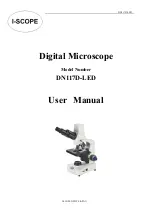
5
6
Microscope Safety Tips
Keep these safety tips in mind as you enjoy hours of fun projects and
experiments with your microscope.
•
Read all instructions before use. Follow them and keep them for
future reference.
•
Keep small children and animals away from any experiments or projects.
•
When working with samples, keep your hands away from your mouth and
eyes. Eye protection is not included.
•
Always wash your hands carefully after handling any samples and always
dispose of any samples in a safe manner.
•
Handle the prepared slides carefully. They are made of glass.
•
Store your microscope set out of reach of small children.
Taking Care of Your Microscope
•
Always handle the microscope with two hands—one hand around the arm
and another around the base.
•
Always remove and clean the slides from the microscope stage after
each use.
•
Place the microscope in a case, or cover it with a plastic bag after
each use.
•
Clean your microscope with a damp or dry cloth—do not immerse or spray
liquid or water on the microscope.
A Special Reminder About Lenses
The most important parts of your microscope are the lenses. Handle them
with care. If the lenses are dirty or dusty, you can clean them with a soft
cotton cloth or a special lens cleaning tissue. Do not wipe them with a
finger or a regular facial tissue. Avoid any direct contact between the
viewing lenses and the stage. When changing eyepieces, work carefully,
but quickly, to avoid introducing dust into your microscope. Always return
the lens cap to the eyepiece when finished.
Getting Started
1) Insert two AA batteries into the base of the microscope, following the
instructions on page 18.
2) Place the microscope on a flat surface near a bright light or, in the daytime,
a window. Locate the mirror and adjust the angle so that when you look
into the eyepiece you see a bright circle of light.
Do not point the mirror
towards the sun as eye damage may result.
If there is no bright light
available, or if the room lighting is poor, use the microscope’s electric
illuminator lamp. To turn on the illuminator lamp, flip the mirror over so
that the light bulb is aimed upward. The light will come on by itself. Look
through the eyepiece and adjust the angle of the light until you see a
bright circle.
3) Once you can see a bright circle of light in the eyepiece, your microscope
is ready for use.
4) Choose one of the prepared sample slides from your set. Place it under
the two spring clips on top of the stage.
5) Next, choose the magnifying power you want to use. Your microscope can
provide magnifying powers of 50X, 100X, 150X, 300X, and 600X.
Remember that the longer objective lenses used with the higher
magnification 20X eyepiece provide the higher powers. For optimal
viewing, start at the lowest power and work your way upward. Most
observing is done at low power.
We constantly improve and update our products. Sometimes, as a result of these
improvements, what is seen on the package or in the instructions may differ somewhat
in color or content from the product in the package.
Содержание MicroPro EI-5301
Страница 1: ...EI 5301 Grades 3 Ages 8...


























